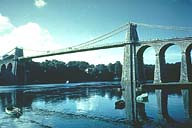
|
Image-GoddenC2
Menai Straits Bridge. This bridge, designed by Telford and completed in 1826 could be described as the first major suspension bridge. The span of 579 ft. was unheard of for any bridge and the chains were made of a new material: wrought iron links, all individually tested. Span and 100 ft. headroom were required for shipping. Following this example, many chain bridges were built. (North Wales)
|
|
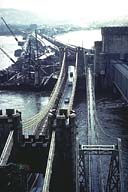
|
Image-GoddenC3
Conway Bridge, on the left. This bridge was also designed by Telford and completed in 1826. It has a span of 327 ft. The slide taken in 1957 shows traffic being diverted to a single lane on the right of the span. Bridges in GoddenC2 and GoddenC3 have been strengthened by replacing the original chains with high tensile steel chains. (North Wales)
|
|
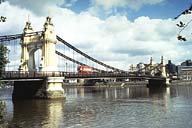
|
Image-GoddenC4
Hammersmith Bridge. This replaced an older bridge completed in 1827 which was the first suspension bridge across the River Thames. This newer bridge was completed in 1887. It is a three-span bridge with spans of 145 ft, 400 ft, and 145 ft. (London, England)
|
|
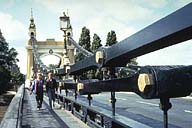
|
Image-GoddenC5
Hammersmith Bridge. Close-up of the double-chained arrangement. Towers are wrought iron encased in cast iron. (The previous bridge used masonry towers with wrought iron chains carried on cast iron saddles resting on roller supports at the towers, as in the bridges of GoddenC2 and GoddenC3) Deck is timber supported on wrought iron cross girders. (London, England)
|
|
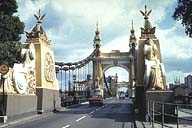
|
Image-GoddenC6
Anchorages of the Hammersmith Bridge. The piers and abutments of the previous bridge were used, resulting in a very narrow roadway (19ft. 9 in.) The bridge is scheduled for replacement. (London, England)
|
|
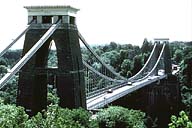
|
Image-GoddenC6.1
Clifton suspension bridge across the gorge of the River Avon near Bristol, England. Designed by I.K. Brunel in 1830, but not completed until 1864, five years after his death. The chain used came from an earlier bridge he had designed, the Hungerford Bridge in London (1845). The main span is 702 ft, the road being 240 ft above the river. It is interesting to note that Telford advised Brunel against this design on account of its windy location, and the wind problems he (Telford) had with the Menai Straits Bridge (GoddenC2). (Near Bristol, England)
|
|
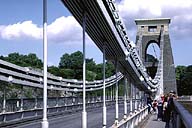
|
Image-GoddenC6.2
Close-up of bridge in GoddenC6.1 showing details of the chains, suspender rods, and stiffening girder. (Near Bristol, England)
|
|
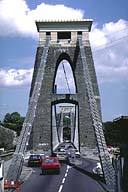
|
Image-GoddenC6.3
View at road level along the axis of the bridge, showing the masonry tower and the back-stay chains. As the towers are built on the cliff face, there are no side spans, hence the back-stay cables are straight except for the small sag due to self weight. (Near Bristol, England)
|
|
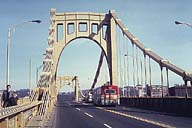
|
Image-GoddenC7
Sixth Street Bridge. In this design the chains are supported on saddles fixed to the top of the towers, in contrast to the structures of GoddenC2-C3. The bridge was completed in 1928. (Pittsburgh, Pennsylvania)
|
|
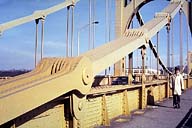
|
Image-GoddenC8
Sixth Street Bridge. Detail of single-chain construction. Compare with the double-chain construction of the Hammersmith Bridge (GoddenC4), and the multi-chain design of the Menai Straits Bridge (GoddenC2). (Pittsburgh, Pennsylvania)
|
|
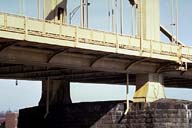
|
Image-GoddenC9
Sixth Street Bridge. Base of the tower. Note the hinged support of the tower on the pier allowing for movement of the top of the tower in the axial direction of the bridge. (Pittsburgh, Pennsylvania)
|
|












